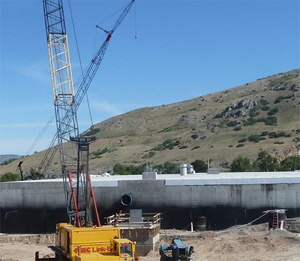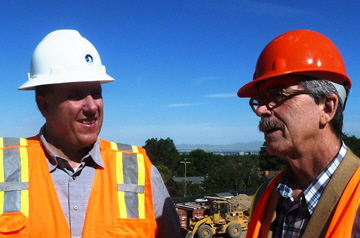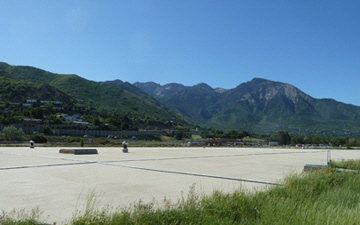Terminal Reservoir Replacement Project
The $42 million phased project is scheduled to be completed in 2018.
July 19, 2013
LeRoy W. Hooton, Jr.
After over 60-years of service the Terminal Reservoir is being replaced. According to Metropolitan Water District of Salt Lake & Sandy (MWDSLS) general manager Mike Wilson, the reservoir is reaching the end of its useful life and will be replaced with structures that meet current seismic standards and improved operational features. “This increases the District’s ability to provide high quality water in a reliable and efficient manner,” says Wilson. Construction is underway and ahead of schedule.
|
The Terminal Reservoir is part of one of two Bureau of Reclamation (BOR) projects that were authorized for construction by the federal government during the mid-1930s: the Provo River Project (PRP) and Salt Lake Aqueduct project (SLA). The Terminal Reservoir (consisting of two 20 million gallon structures) is the terminus of the SLA, which was constructed to deliver water developed by the PRP to Salt Lake City. The key feature of the PRP is the zoned earthfilled Deer Creek Dam located on the Provo River 16 miles northeast of Provo City. Other major features are diversion structures on the Duchesne River, Weber River, and Murdock Diversion Dam on the Provo River, a power plant at the dam, Provo Reservoir Canal enlargement and the Jordan Narrows Siphon and pumping plant.
The PRP and SLA were conceived during extraordinary times. The Great Basin and mid-western states were wreaked with a decade-long drought, creating the Dust Bowl in the southern plains. Also, the nation was in the throes of the Great Depression with 25 percent of its work force unemployed. In the midst of these dismal conditions, Salt Lake City was desperately seeking an outside (of the Salt Lake valley) water storage project to serve a growing population and protect the city’s inhabitants against droughts. The City’s first choice was a dam and reservoir on the Provo River.
Fortunately for the City, this was the era of the depression fighting New Deal public works policies of President Franklin D. Roosevelt and intensive federal dam building in the West by the BOR, which created the favorable circumstances that led to the construction of the PRP and SLA.
The federal government financed and built PRP and SLA and the sponsors were given 40 years to repay the reimbursable costs of these projects with no interest paid on the principle.
The PRP was a seminal water development project for Utah. It collects flood and surplus waters from 3 major basins: the Duchesne, Weber and Provo drainages. Moreover, it captures a portion of Utah’s share of the Colorado River for beneficial use along the Wasatch Front.
Deer Creek Dam forms a 152,700 acre-foot reservoir in Provo Canyon. Project water is delivered to farmers in Summit and Wasatch Counties; and in Utah County through the enlarged Provo Reservoir Canal (aka the Murdock Canal). It also developed domestic water supply for metropolitan water districts of Salt Lake City, Provo, Orem, Pleasant Grove, Lindon, American Fork and Lehi.
As a separate project, municipal water supply to eastern Salt Lake County is conveyed through the 41-mile SLA to the Terminal Reservoir located at 3300 South, west of I-215 where the water is distributed into Salt Lake City’s system. The 69-inch in diameter concrete pipeline has a flow capacity of 150 cubic feet per second.
In order for the local sponsors to contract with the federal government it was necessary to establish two new entities – the Provo River Water Users Association to sponsor the PRP and the Metropolitan Water District of Salt Lake City (now the Metropolitan Water District of Salt Lake & Sandy) to sponsor the SLA. These new entities would be responsible to repay the reimbursable construction costs and operate, maintain, replace, enlarge, and improve the related facilities of their respective projects.
|
On August 15, 1934 Salt Lake City held an election to form the new district for the purpose of petitioning water from PRP, and contracting with the federal government to construct and repay the costs of the SLA. The proposition passed 53 percent for and 47 percent against.
The PRWUA, formed in 1937 contracted with the federal government for the construction and repayment of costs of the PRP. Water petitioners subscribed for water from the PRP and were issued stock in this non-profit corporation. PRWUA issued 100,000 shares of capital stock.
On November 23, 1937 the MWDSLS held an election to authorize the district to petition for 46,000 shares of stock in PRWUA and enter into a contract with the federal government to construct the SLA. Both propositions passed by 23 to 1 ratios by Salt Lake City voters. Today, MWDSLS owns 61.7 percent of the stock in PRWUA.
The PRP was authorized under the provisions of the National Industrial Recovery Act of June 16, 1933 and approved by President Roosevelt on November 16, 1935. The SLA was approved by the President on October 24, 1938.
Construction of the PRP began in May 1938, and water was made available to irrigation stockholders when Deer Creek Dam was completed in 1941. Construction of the SLA began in 1940 and was completed in the fall of 1950 at a cost in excess of $11 million. Water deliveries to Salt Lake City from Deer Creek began in 1951, when the Terminal Reservoir was completed; however, because of the quality of Deer Creek water, it was necessary to halt using this water for municipal use until a water treatment plant was built.
Completed in 1960, the non-federally funded Little Cottonwood Water Treatment Plant (LCWTP) treats raw water from Deer Creek and Little Cottonwood Creek from the raw water reach of the SLA; and then delivers treated water through the finished water reach of the SLA to the Terminal Reservoir. Constructed in the 1990s, there is an intermediate reservoir on the SLA between the treatment plant and Terminal Reservoir. Costing $7.5 million, Salt Lake City taxpayers approved the bond for the construction of the treatment facility by an 8 to 1 margin.
Since first constructed, major improvements have been made to key features of the PRP. In 2009, in order to meet dam safety requirements, the BOR made improvements to Deer Creek dam. In 2013, the PRWUA enclosed the Provo Reservoir Canal in a pipeline at a cost of $150 million.
As a prelude to replacing the Terminal Reservoir, on October 2, 2006, the federal government conveyed ownership (title transfer) of the SLA and related facilities to MWDSLS.
In 2010, MWDSLS decided to replace the Terminal Reservoir with the purpose of meeting current seismic standards, up-grading valves and control features and installing new disinfection and de-disinfection treatment equipment. The replacement reservoir is designed to enhance water quality treatment. “The timing of the project was favorable,” says Wilson, continuing, “Favorable financing options … and a favorable bidding climate contributed to the decision to move forward on the project.”
The work was divided into Phases 1 – 5 as follows:
|
Phase I – Yard piping-- $16,299,955.55
Phase II - Chemical building--$533,867.83
Phase III – Sam Park West--$4,562,143.28
Phase IV – Terminal Reservoir North--$10,313,355.82
Phase V – Terminal Reservoir South--$4,974,677.52
Design documents were completed in August 2011 and the construction contract divided into 5-phases was awarded to Salt Lake City based Alder Construction in September 2011 for $42,237,855.00. During 2012, the contractor was given notice to proceed with Phases 1-3. The work is scheduled in phases to ensure full service at all times during the construction period, which is expected to be completed in 2018. When completed, the replaced Terminal Reservoir complex will have 48.8 million gallons of capacity.
The contractor is estimating that 200,000 man-hours and 32,000 cubic yards of concrete will be needed to complete the project.
According to Wilson, the project is ahead of schedule. Phases 1 – 3 are nearly completed. Currently the Phase 3 Sam Park West Reservoir is being tested in preparation for putting it into service. This 9.0 million gallon reservoir will replace some of the capacity lost during the period when Terminal Reservoirs North and then South are out of service during demolition and reconstruction; and at the end of construction will increase the overall capacity of the Terminal Reservoir. In August 2013 the contractor will begin Phase 4 of the project, by demolishing and replacing Terminal Reservoir North. Total project expenses to date are $20,542,760.64.


